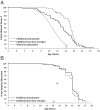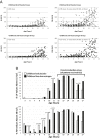Effects of low-dose estrogen replacement during childhood on pubertal development and gonadotropin concentrations in patients with Turner syndrome: results of a randomized, double-blind, placebo-controlled clinical trial
- PMID: 24762109
- PMCID: PMC4154082
- DOI: 10.1210/jc.2013-4518
Effects of low-dose estrogen replacement during childhood on pubertal development and gonadotropin concentrations in patients with Turner syndrome: results of a randomized, double-blind, placebo-controlled clinical trial
Abstract
Context: The optimal approach to estrogen replacement in girls with Turner syndrome has not been determined.
Objective: The aim of the study was to assess the effects of an individualized regimen of low-dose ethinyl estradiol (EE2) during childhood from as early as age 5, followed by a pubertal induction regimen starting after age 12 and escalating to full replacement over 4 years.
Design: This study was a prospective, randomized, double-blind, placebo-controlled clinical trial.
Setting: The study was conducted at two US pediatric endocrine centers.
Subjects: Girls with Turner syndrome (n = 149), aged 5.0-12.5 years, were enrolled; data from 123 girls were analyzable for pubertal onset.
Intervention(s): Interventions comprised placebo or recombinant GH injections three times a week, with daily oral placebo or oral EE2 during childhood (25 ng/kg/d, ages 5-8 y; 50 ng/kg/d, ages >8-12 y); after age 12, all patients received escalating EE2 starting at a nominal dosage of 100 ng/kg/d. Placebo/EE2 dosages were reduced by 50% for breast development before age 12 years, vaginal bleeding before age 14 years, or undue advance in bone age.
Main outcome measures: The main outcome measures for this report were median ages at Tanner breast stage ≥2, median age at menarche, and tempo of puberty (Tanner 2 to menarche). Patterns of gonadotropin secretion and impact of childhood EE2 on gonadotropins also were assessed.
Results: Compared with recipients of oral placebo (n = 62), girls who received childhood low-dose EE2 (n = 61) had significantly earlier thelarche (median, 11.6 vs 12.6 y, P < 0.001) and slower tempo of puberty (median, 3.3 vs 2.2 y, P = 0.003); both groups had delayed menarche (median, 15.0 y). Among childhood placebo recipients, girls who had spontaneous breast development before estrogen exposure had significantly lower median FSH values than girls who did not.
Conclusions: In addition to previously reported effects on cognitive measures and GH-mediated height gain, childhood estrogen replacement significantly normalized the onset and tempo of puberty. Childhood low-dose estrogen replacement should be considered for girls with Turner syndrome.
Trial registration: ClinicalTrials.gov NCT00001221.
Figures



Comment in
-
Therapy: Turner syndrome--estrogen therapy in childhood normalizes pubertal onset.Nat Rev Endocrinol. 2014 Jul;10(7):379. doi: 10.1038/nrendo.2014.72. Epub 2014 May 13. Nat Rev Endocrinol. 2014. PMID: 24821325 No abstract available.
References
-
- Stochholm K, Juul S, Juel K, Naeraa RW, Gravholt CH. Prevalence, incidence, diagnostic delay, and mortality in Turner syndrome. J Clin Endocrinol Metab. 2006;91(10):3897–3902 - PubMed
-
- Bondy CA, Turner Syndrome Study Group. Care of girls and women with Turner syndrome: a guideline of the Turner Syndrome Study Group. J Clin Endocrinol Metab. 2007;92(1):10–25 - PubMed
-
- Saenger P, Wikland KA, Conway GS, et al. Recommendations for the diagnosis and management of Turner syndrome. J Clin Endocrinol Metab. 2001;86(7):3061–3069 - PubMed
-
- Jenner MR, Kelch RP, Kaplan SL, Grümbach MM. Hormonal changes in puberty. IV. Plasma estradiol, LH, and FSH in prepubertal children, pubertal females, and in precocious puberty, premature thelarche, hypogonadism, and in a child with a feminizing ovarian tumor. J Clin Endocrinol Metab. 1972;34(3):521–530 - PubMed
-
- Winter JS, Faiman C. Serum gonadotropin in concentrations in agonadal children and adults. J Clin Endocrinol Metab. 1972;35(4):561–564 - PubMed
Publication types
MeSH terms
Substances
Associated data
LinkOut - more resources
Full Text Sources
Other Literature Sources
Medical

